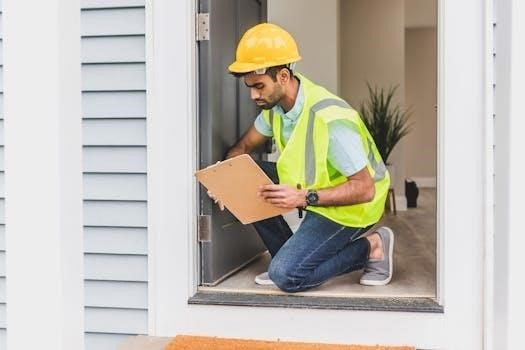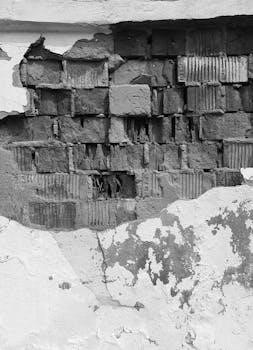A building construction checklist in PDF format serves as a crucial tool for managing and overseeing construction projects. It provides a structured approach, ensuring all essential steps are completed. This digital checklist helps contractors, builders, and homeowners maintain control, minimize errors, and track progress effectively throughout the building process.
Importance of a Building Construction Checklist

The importance of a building construction checklist cannot be overstated, as it provides a systematic approach to managing complex projects. A comprehensive checklist helps to maintain control over the entire construction process, from initial site work to final inspections. By utilizing a checklist, potential mistakes can be identified early, minimizing costly rework and delays. This is particularly crucial for ensuring that the project stays on schedule and within budget. A well-structured checklist serves as a communication tool, ensuring everyone involved understands their roles and responsibilities.
Furthermore, a building construction checklist ensures compliance with building codes and regulations, reducing the risk of legal issues and safety hazards. It provides a clear record of completed tasks, which is essential for quality control and accountability. The checklist also aids in material management, ensuring that all necessary materials are available when needed. By promoting organization and attention to detail, a building construction checklist enhances the overall efficiency and success of the construction project. Ultimately, it leads to a safer, more reliable, and more cost-effective outcome for all stakeholders.
Stages of Home Construction Checklist
The stages of home construction checklist outline the sequential steps involved in building a house, ensuring each phase is completed thoroughly before moving to the next. The initial stage typically includes site work, such as clearing the land, grading, and setting up temporary utilities. Next, the foundation is laid, involving excavation, pouring concrete, and ensuring proper curing. Framing follows, where the structure’s skeleton is erected, including walls, floors, and roof. Subsequently, electrical, plumbing, and HVAC systems are installed, requiring careful coordination and adherence to codes.
After the essential systems are in place, interior finishes are addressed. This encompasses insulation, drywall, painting, flooring, and cabinetry. Exterior finishes then come into play, including siding, roofing, windows, and doors. Landscaping and exterior detailing add the final touches. Finally, a final inspection is conducted to verify compliance with all regulations and ensure the home meets the required standards. Each stage of the construction checklist ensures a well-organized process.
Site Work Checklist
The site work checklist is a critical first step in any construction project, ensuring the land is properly prepared before building begins. Initially, the checklist verifies that the building permit is obtained and displayed. Site clearing is next, involving the removal of trees, debris, and vegetation. Erosion control measures must be implemented to prevent soil runoff and protect the surrounding environment. Grading and leveling follow, ensuring a stable and even surface for the foundation. Utility locations are identified and marked to avoid damage during excavation.
Temporary utilities, such as water and electricity, are established for construction use. A soil test is conducted to assess the ground’s stability and load-bearing capacity. The construction entrance is defined and stabilized to prevent tracking mud onto public roads. Finally, proper drainage is ensured to manage stormwater runoff. Completing the site work checklist thoroughly sets the stage for a successful construction project, minimizing potential issues later on and ensuring a safe and compliant worksite.
Foundation Checklist
The foundation checklist is an indispensable part of the building construction process, guaranteeing the structural integrity of the building. It begins with verifying the accurate layout of the foundation according to the approved plans. Proper excavation depths and dimensions are confirmed before proceeding. Reinforcement steel, including rebar placement, is inspected to ensure it meets engineering specifications. Formwork is checked for stability and alignment to prevent concrete leaks and ensure correct dimensions. Anchor bolts are installed accurately to secure the framing to the foundation.
A pre-pour inspection is conducted to verify all preparations are complete and compliant. Concrete mix design is reviewed to ensure it meets the required strength and durability. During the concrete pour, proper placement and consolidation are monitored. Curing procedures are followed to achieve optimal concrete strength. After curing, the foundation is inspected for cracks, voids, and proper elevation. Finally, backfilling is performed carefully to provide proper support and drainage, setting the stage for subsequent construction phases.
Framing Checklist
The framing checklist is a critical element in ensuring the structural integrity of a building. It begins with verifying that the framing materials meet specified grades and dimensions. The layout is checked against approved plans, confirming proper wall placement and dimensions. Wall studs are inspected for correct spacing and alignment, ensuring they are plumb and level. Headers above windows and doors are assessed for proper size and installation, providing adequate support. Joists and rafters are examined for correct spacing, span, and securement.

Sheathing is verified for proper attachment and coverage, contributing to structural stability. Connections, including nails, screws, and fasteners, are inspected for compliance with codes and specifications. Bracing is checked to ensure lateral stability during and after construction. Fire blocking is inspected to prevent the spread of fire within walls and floors. The overall squareness and alignment of the framing are confirmed before proceeding. Any discrepancies or deviations are addressed before moving to the next construction phase, ensuring a solid and safe structure.

Electrical Checklist
The electrical checklist is paramount for safety and functionality in any construction project. It begins with verifying that all wiring complies with the National Electrical Code (NEC) and local regulations. Proper grounding is checked to prevent electrical shocks and ensure safety. Wiring connections are inspected for secureness and insulation, preventing shorts and hazards. Electrical panels are assessed for proper labeling and circuit breaker functionality.
Outlets and switches are verified for correct installation and grounding, ensuring safe operation. Lighting fixtures are inspected for secure mounting and proper wiring. Smoke detectors and carbon monoxide detectors are checked for correct placement and functionality. Conduits and raceways are inspected for proper installation and protection of wiring. Any exposed wiring or hazardous conditions are immediately addressed. Before energizing the system, a thorough inspection is conducted to ensure all components are safe and compliant. This detailed checklist minimizes the risk of electrical fires and ensures a safe electrical system.
Plumbing Checklist
A comprehensive plumbing checklist is vital for ensuring a functional and leak-free water system in any building project. It starts with verifying that all plumbing work adheres to local codes and regulations. The checklist includes inspecting water supply lines for proper sizing, material, and secure connections. Drain lines are checked for correct slope and venting to prevent clogs and sewer backups. Fixture installations, including sinks, toilets, showers, and tubs, are examined for proper sealing and functionality.
Water heaters are inspected for correct installation, venting, and temperature settings. Backflow preventers are verified to safeguard the potable water supply from contamination. Pressure testing is conducted to identify leaks in the system. Septic systems or sewer connections are inspected for compliance and proper function. All pipes are checked for insulation to prevent freezing and condensation. A final inspection ensures all plumbing components are operating efficiently and without leaks. This checklist guarantees a safe and reliable plumbing system.
HVAC Checklist
An HVAC (Heating, Ventilation, and Air Conditioning) checklist is essential for ensuring a comfortable and energy-efficient indoor environment. The checklist begins with verifying that the HVAC system design aligns with the building’s size and climate. It includes inspecting the installation of the furnace or heat pump, ensuring proper venting and gas connections are secure. Air conditioning units are checked for correct refrigerant levels and efficient operation. Ductwork is examined for proper sealing and insulation to prevent air leaks and energy loss. Thermostats are tested for accurate temperature control and programming.
Air filters are inspected for cleanliness and correct installation. Ventilation systems are verified to provide adequate fresh air intake and exhaust. All electrical connections are checked for safety and compliance with codes. A final system test ensures optimal performance and energy efficiency. The checklist also includes verifying proper condensate drainage to prevent water damage. Regularly reviewing and completing this HVAC checklist helps maintain a comfortable and healthy living space while minimizing energy consumption and costs. Proper HVAC functioning is paramount for building longevity.
Interior Finishes Checklist
The interior finishes checklist is a vital tool for ensuring the aesthetic appeal, functionality, and quality of a building’s interior spaces. This checklist starts with verifying the proper installation of drywall, including smooth seams and a level surface ready for painting or wallpaper. Painting is inspected for consistent color, even coverage, and clean lines. Flooring materials, such as hardwood, tile, or carpet, are checked for correct installation, level surfaces, and secure attachments. Trim work, including baseboards, crown molding, and door casings, is assessed for proper alignment, secure fastening, and smooth finishes.
Doors and windows are inspected for smooth operation, proper sealing, and secure hardware. Cabinetry and countertops are checked for correct installation, level surfaces, and quality craftsmanship. Plumbing fixtures, such as sinks, toilets, and showers, are verified for proper installation, leak-free connections, and smooth operation. Electrical fixtures, including outlets, switches, and lighting, are inspected for correct wiring, secure mounting, and proper functionality. The checklist concludes with a thorough review of all finishes for any defects or imperfections, ensuring a high-quality and aesthetically pleasing interior space.
Exterior Finishes Checklist
The exterior finishes checklist is crucial for ensuring a building’s curb appeal, weather resistance, and long-term durability. This checklist starts with verifying the proper installation of siding materials, such as vinyl, wood, or fiber cement, ensuring secure attachment and weather-tight seals. The checklist includes inspecting the roof for correct shingle or tile installation, proper flashing around chimneys and vents, and adequate ventilation. Windows and doors are checked for proper sealing to prevent air and water leaks, ensuring energy efficiency and comfort.
Exterior trim, including soffits, fascia, and corner boards, is assessed for secure attachment and proper sealing to protect against weather damage. Paint or stain is inspected for even coverage, proper application, and weather resistance. Gutters and downspouts are checked for secure attachment, proper slope for drainage, and clear pathways for water flow. Landscaping elements, such as walkways, driveways, and plantings, are reviewed for proper installation, drainage, and aesthetic appeal. Site grading is inspected to ensure proper water runoff away from the foundation. This checklist concludes with a comprehensive review of all exterior finishes, ensuring a visually appealing and well-protected building.
Final Inspection Checklist
The final inspection checklist is a critical step in the construction process, ensuring the building meets all safety, structural, and regulatory requirements before occupancy. This checklist involves a comprehensive review of all aspects of the construction project, starting with verifying that all items from previous checklists have been addressed and resolved. Structural elements are re-inspected for integrity and compliance with building codes, ensuring the building’s stability and safety.

The electrical system undergoes a final check to confirm proper wiring, grounding, and functioning of all outlets, switches, and fixtures. Plumbing fixtures are tested for leaks, proper drainage, and compliance with water conservation standards. The HVAC system is assessed for efficient operation, proper ventilation, and adherence to energy efficiency requirements. Interior finishes are reviewed for quality, completeness, and adherence to design specifications. Exterior elements, including landscaping, grading, and drainage, are inspected for proper installation and functionality. The checklist concludes with verifying that all required permits and documentation are in place, ensuring compliance with local regulations and facilitating a smooth handover to the owner.